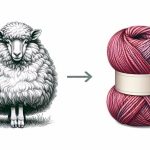Are you curious about how spinning wheels work? These fascinating machines have been around for centuries, allowing people to create their own yarn from raw materials such as wool and cotton.
In this article, we will explore the history of spinning wheels, the components that make them work, and the process of spinning yarn. Spinning wheels have played an important role in the textile industry, allowing people to create their own clothing and textiles.
But how exactly do they work? By understanding how the components of a spinning wheel work together, you can gain a better appreciation for this ancient art form and even try your hand at spinning your own yarn.
So let’s dive in and discover the inner workings of the spinning wheel!
Table of Contents
Brief History of the Spinning Wheel
You’ll want to delve into the fascinating history of the spinning wheel, which has been an essential tool for textile production for centuries.
The first spinning wheel was invented in India around 500 AD, and it revolutionized the process of spinning yarn. Before the spinning wheel, yarn was spun by hand using a spindle, and it was a slow and laborious process. The spinning wheel made it possible to spin yarn much faster and more efficiently.
From India, the spinning wheel spread to the Middle East and Europe, where it continued to evolve. By the 16th century, the spinning wheel had become a common tool in households throughout Europe, and it became a symbol of the Industrial Revolution.
The spinning wheel was used to spin the yarn that was then woven into cloth, which was a crucial step in the production of textiles. Although the spinning wheel has been largely replaced by modern spinning machines, it remains an important part of textile history.
Many people still use spinning wheels today to create their own yarn and textiles. The spinning wheel is also a symbol of the ingenuity and creativity of our ancestors, who were able to create such a useful tool using only simple materials.
The Components of a Spinning Wheel
The various parts of a spinning wheel come together to create a tool that produces yarn. The components vary slightly depending on the type of spinning wheel, but the basic parts remain the same. Firstly, there is the drive wheel that is rotated by the spinner’s foot or a drive band. The drive wheel is connected to a spindle, which is the part that holds the fiber and twists it into yarn.
In addition to the drive wheel and spindle, spinning wheels have a flyer, which is a U-shaped component that holds the bobbin. The flyer rotates around the spindle and the bobbin rotates around the flyer, allowing for the yarn to be wound onto the bobbin as it is spun. The orifice, or the hole in the flyer, allows the fiber to be pulled through and into the spinning wheel, where it is twisted into yarn.
As you can see in the table below, each component of the spinning wheel plays a crucial role in the process of creating yarn. Without any of these parts, the spinning wheel would not be able to function properly and the spinner would not be able to produce yarn. Understanding the components of a spinning wheel is important for anyone who wants to learn how to spin yarn and become proficient in the craft.
| Component | Function | |
|---|---|---|
| Drive Wheel | Rotates the spindle | |
| Spindle | Holds the fiber and twists it into yarn | |
| Flyer | Holds the bobbin and rotates around the spindle | |
| Bobbin | Collects the spun yarn | |
| Orifice | Allows fiber to be pulled through and into the spinning wheel | …where it is twisted into yarn by the spindle and wound onto the bobbin by the flyer. |
Understanding the Twisting Process
Understanding how yarn is twisted is essential for anyone learning to spin with a spinning wheel. The twisting process is what turns loose fibers into yarn. As you spin your wheel, the fibers are pulled onto the bobbin and twisted together.
The degree of twist will determine the strength and durability of your yarn. To understand the twisting process, it helps to know that there are two main types of twists: S-twist and Z-twist. S-twist is when the fibers are twisted to the left, and Z-twist is when they are twisted to the right.
Most spinning wheels are set up to create Z-twist yarn, but you can switch the direction by adjusting the tension and direction of the wheel. To achieve the desired amount of twist, you need to adjust the tension and speed of your wheel.
More tension will create more twist, while less tension will create less twist. The speed at which you spin also plays a role in the amount of twist. Faster speeds will create more twist, whereas slower speeds will create less twist.
It takes practice to find the right balance between tension and speed to achieve the perfect amount of twist for your yarn.
Different Types of Spinning Wheels
So, you’re interested in learning about different types of spinning wheels? Well, let’s start with Saxony Wheels. These classic spinning wheels have a horizontal orientation and are known for their smooth and quiet operation.
Then there are Castle Wheels, which have a vertical orientation and are great for spinning lightweight yarns.
Finally, Modern Spinning Wheels come in a variety of styles and are designed for easy use and portability.
Saxony Wheels
You might be surprised at how efficient a Saxony wheel can be when spinning wool into yarn. Here are a few reasons why:
-
The horizontal orientation of the wheel allows for more consistent tension on the yarn, resulting in a smoother and more even spin.
-
The long, narrow flyer allows for a longer length of yarn to be spun before needing to be wound onto the bobbin.
-
The double drive system, with both the drive band and the brake band, provides greater control over the speed and tension of the spinning wheel.
-
The compact size of the Saxony wheel makes it easy to transport and store, making it a popular choice for spinners on the go.
Overall, the Saxony wheel is a reliable and efficient tool for spinning wool into yarn. Whether you’re a beginner or an experienced spinner, this classic spinning wheel is definitely worth considering for your next fiber art project.
Castle Wheels
If you’re looking for a spinning wheel that’s easy to use and great for beginners, castle wheels might be the perfect choice for you. These wheels are named for their castle-like shape, with the flyer and bobbin assembly situated above the wheel.
This design allows for a more compact and portable wheel, making it a popular choice for spinners who like to take their craft on the go. Castle wheels also tend to have a more direct drive system, which means that the flyer is directly connected to the wheel.
This can make it easier to get started spinning, as there are fewer parts to keep track of and adjust. Additionally, castle wheels often have a smaller orifice, which can be helpful for beginners who are still getting used to drafting and controlling their fiber.
Overall, if you’re looking for a spinning wheel that’s simple, compact, and easy to use, a castle wheel could be a great option for you.
Modern Spinning Wheels
Modern spinning wheels have evolved to be more efficient and user-friendly, incorporating features such as adjustable tension and larger bobbins for longer spinning sessions.
Unlike castle wheels, modern spinning wheels have a flyer that rotates around the bobbin, allowing the yarn to be spun onto the bobbin at a much faster rate. This also allows spinners to create more consistent yarn as the tension can be adjusted to control the speed of the flyer.
Another advantage of modern spinning wheels is the ability to change the ratio of the spinning wheel. This means that the speed of the flyer can be adjusted to suit the type of fiber being spun, making it easier to create a variety of yarns with different thicknesses and textures.
Additionally, modern spinning wheels are often made from lightweight materials such as aluminum or composite materials, making them easier to transport and move around the house.
Overall, the evolution of spinning wheels has made it easier for spinners to create high-quality yarns with less effort and more control.
How to Spin Yarn on a Spinning Wheel
Are you ready to learn how to spin yarn on a spinning wheel?
First, you’ll need to prepare your fiber by carding or combing it to remove any tangles or debris.
Then, it’s time to set up your spinning wheel by adjusting the tension and attaching your fiber to the bobbin.
Finally, you’ll use various spinning techniques, such as drafting and treadling, to create the yarn of your desired thickness and texture.
Get ready to unleash your creativity and make beautiful, handmade yarn!
Preparing the Fiber
First, you’ll need to card your fiber to remove any tangles or knots and align the fibers in the same direction. This can be done using hand carders or a drum carder. Hand carders are small paddles with wire teeth that can be used to blend and align fibers. A drum carder is a larger machine that can process larger amounts of fiber at once.
Once your fiber is carded, you can move on to the next step of preparing it for spinning. Next, you’ll want to divide your carded fiber into small sections called rovings. This can be done by pulling apart the carded fiber with your hands, or by using a diz tool. A diz is a small disk with a hole in the center that can be used to pull the fibers through, creating a long, thin strand of fiber.
Once you have your rovings, you can begin spinning them into yarn on your spinning wheel. By properly preparing your fiber, you’ll have a smoother and more consistent yarn.
To prepare your fiber, gather your fiber and carding tools. Place a small amount of fiber on the carding surface, and use the carding tool to brush the fibers, removing tangles and aligning them. Repeat the process until all fiber is carded.
Setting up the Spinning Wheel
Now that you have your fiber carded and ready to go, it’s time to set up your spinning wheel so you can start creating your yarn masterpiece! The first step is to position the drive band on the wheel and flyer. Make sure the drive band is tight enough to spin the flyer, but not so tight that it causes unnecessary friction. Next, insert the bobbin into the flyer and slide it onto the spindle, making sure it is secure. Finally, adjust the tension knob to create the desired tension on the yarn as it is spun.
Once your spinning wheel is set up, it’s time to start spinning! Sit in front of the wheel with your fiber in hand and begin to treadle the wheel with your foot. As the wheel turns, use your fingers to guide the fiber onto the flyer and begin to spin the yarn. Keep a consistent pace and tension to create an even yarn. Remember to periodically stop and adjust the tension knob as needed. With practice and patience, you’ll be able to create beautiful, unique yarns using your spinning wheel.
| Step | Description | Image |
|---|---|---|
| 1 | Position the drive band |  |
| 2 | Insert bobbin into flyer and secure onto spindle |  |
| 3 | Adjust tension knob |  |
Spinning Techniques
Once you’ve got the hang of it, you’ll love experimenting with different techniques to add texture and interest to your yarn.
One popular technique is called ‘woolen spinning,’ which involves holding the fiber loosely and allowing air to be trapped between the fibers. This creates a light, airy yarn with a halo effect.
Another technique is ‘worsted spinning,’ which involves holding the fiber tightly and combing it before spinning. This creates a smooth, dense yarn with less elasticity.
To take your spinning to the next level, consider using different drafting techniques. ‘Long draw drafting’ involves pulling the fiber back and allowing it to twist on its own, creating a soft, lumpy yarn. ‘Short draw drafting’ involves pulling the fiber forward and controlling the twist with your hands, creating a smooth, even yarn.
By experimenting with different techniques and drafting methods, you can create a range of unique and beautiful yarns to use in your projects.
Common Spinning Wheel Issues and How to Fix Them
If you’re experiencing issues with your spinning wheel, don’t worry! There are a few common problems that can easily be fixed.
Tension issues can make your yarn too loose or too tight, which can be frustrating.
Broken or bent hooks can also cause problems, but they can be easily replaced.
Finally, worn or loose drive bands can cause slips and uneven spinning, but they can also be replaced.
Tension Issues
Tension problems can cause your spinning wheel to produce uneven or inconsistent yarn. When the tension is too loose, the yarn won’t be held tightly enough, resulting in a thick and fluffy yarn. On the other hand, if the tension is too tight, the yarn will be thin and tightly twisted.
Here are three things you can do to fix tension issues:
-
Adjust the tension knob: The tension knob controls how much tension is applied to the yarn as it’s spun. If the yarn’s too loose, tighten the knob. If it’s too tight, loosen the knob.
-
Check the drive band: The drive band is the band that connects the spinning wheel to the flyer. If the drive band’s too loose, it’ll cause the flyer to spin too slowly, resulting in loose yarn. If it’s too tight, it’ll cause the flyer to spin too quickly, resulting in tight yarn.
-
Use a different type of yarn: Some yarns require more tension than others. If you’re having tension issues with a particular type of yarn, try using a different type to see if it makes a difference. Always remember to test the tension on a small sample before committing to a large project.
Broken or Bent Hooks
To fix broken or bent hooks on your spinning wheel, you’ll need to carefully examine the hook and determine if it can be repaired or needs to be replaced. Start by removing the hook from the wheel and inspect it closely.
If the hook is only slightly bent, you may be able to straighten it out using pliers or a small hammer. However, if the hook is severely bent or broken, it will need to be replaced entirely.
Replacing a hook on your spinning wheel is a fairly simple process. First, make sure you have the correct replacement hook for your wheel. Then, remove the old hook by unscrewing it from the wheel.
Next, screw the new hook into place, making sure it is secure and straight. Finally, adjust the tension on your wheel and test it out to make sure the new hook is working properly.
With a little bit of patience and some basic tools, you can easily fix any broken or bent hooks on your spinning wheel.
Worn or Loose Drive Bands
Don’t let worn or loose drive bands slow down your spinning – with a few simple steps, you can easily replace them and get back to creating beautiful yarn.
The drive band is an essential part of your spinning wheel, as it connects the flyer and the bobbin whorl, causing the bobbin to spin and wind the yarn. Over time, the drive band can stretch and become worn, which can cause slipping or even breakage.
To replace a worn or loose drive band, first, remove the old band from the wheel and measure the circumference of the wheel and bobbin whorl. Then, cut a new drive band to the correct length, making sure it’s not too tight or too loose.
Next, loop the band around the wheel and bobbin whorl, making sure it’s snugly in place. Finally, test the new band by spinning the wheel and seeing if the bobbin turns smoothly.
With a new, properly fitted drive band, you can get back to spinning with ease.
- Tetron Fabric for Marine Applications: Durability and Use Cases - June 18, 2025
- Tetron Fabric for Outdoor Furniture: Weather Resistance and Care - June 18, 2025
- Tetron Fabric for Wall Coverings: Style and Application Tips - June 18, 2025





